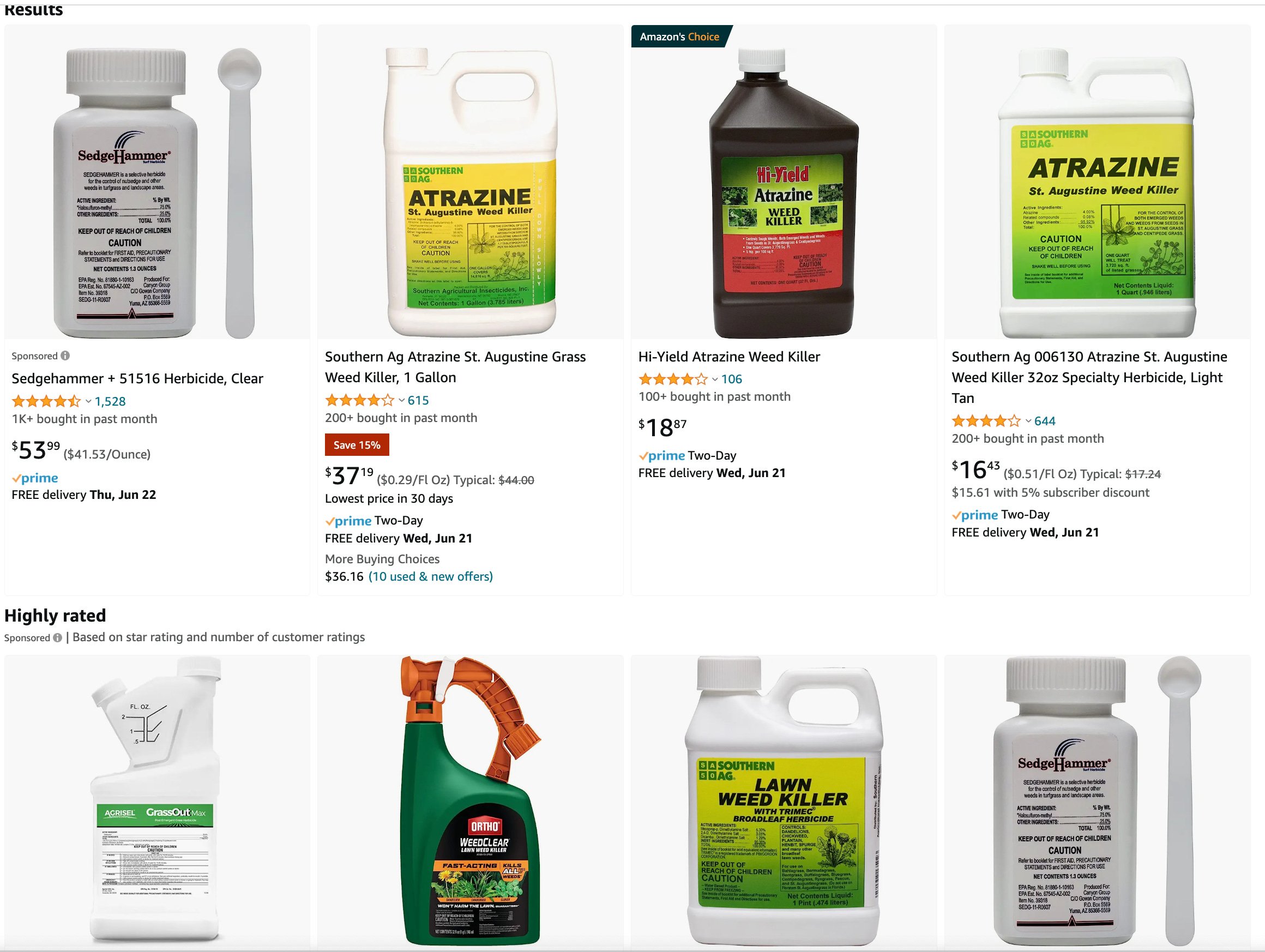Kennedy is right - Atrazine and Gender Fluidity
It will affect reproductive development and health.
Atrazine is one of the most commonly used herbicides in the world, and is often used to control weeds in commercial crops. It is also available on Amazon for home use.
Atrazine is applied to corn, sorghum and sugarcane as well as on turf, such as golf courses and residential lawns.
Atrazine is an endocrine disrupter, which is able both demasculinize (chemically castrate) and completely feminize adult male frogs as well as other aquatic life. It has been documented to affect murine (mouse) reproductive systems.
That endocrine disruptors found in this herbicide will make its way into puddles, ponds, lakes, streams, rivers and even ocean is well proven. That these herbicides are feminizing aquatic life is well proven. That is well established in the scientific literature. From a paper published in 2010,
Atrazine induces complete feminization and chemical castration in male African clawed frogs (Xenopus laevis)
Abstract: The herbicide atrazine is one of the most commonly applied pesticides in the world. As a result, atrazine is the most commonly detected pesticide contaminant of ground, surface, and drinking water. Atrazine is also a potent endocrine disruptor that is active at low, ecologically relevant concentrations. Previous studies showed that atrazine adversely affects amphibian larval development. The present study demonstrates the reproductive consequences of atrazine exposure in adult amphibians.
Atrazine-exposed males were both demasculinized (chemically castrated) and completely feminized as adults. Ten percent of the exposed genetic males developed into functional females that copulated with unexposed males and produced viable eggs.
Atrazine-exposed males suffered from depressed testosterone, decreased breeding gland size, demasculinized/feminized laryngeal development, suppressed mating behavior, reduced spermatogenesis, and decreased fertility. These data are consistent with effects of atrazine observed in other vertebrate classes.
The present findings exemplify the role that atrazine and other endocrine-disrupting pesticides likely play in global amphibian declines.
It is also true that even common foods which are endocrine disruptors can cause feminization in adult human males:
Such as documented in this case study:
Secondary Hypogonadism due to Excessive Ingestion of Isoflavone in a Man
Intern Med 2022 Oct 1;61(19):2899-2903. doi: 10.2169/internalmedicine.8578-21. Epub 2022 Feb 26.
Abstract: A 54-year-old man had been drinking approximately 1.2 L of soy milk (equivalent to approximately 310 mg of isoflavones) per day for the previous 3 years. He then developed erectile dysfunction and gynecomastia. On an examination in our department in May, blood tests showed low gonadotropin and testosterone levels, indicative of secondary hypogonadism. He stopped drinking soy milk on his own in June of that year. When he was admitted in August, blood tests showed an improved gonadal function. Secondary hypogonadism caused by the excessive intake of isoflavones in soy milk was diagnosed. In men, an excessive intake of isoflavones may cause feminization and secondary hypogonadism.
Personally, I call into question the author’s conclusions above. Atrazine is used extensively on soybeans. The diagnosis of the author was that it was the isoflavones in soy milk that caused this man’s secondary hypogonadism. However, atrazine levels and other herbicides/pesticides weren’t considered or even mentioned in the paper. The authors or physicians assumed a diagnosis without considered the use of endocrine disruptors (there are many pesticides that are also endocrine disruptors) on soybean crops. It could be that he had been drinking soy milk contaminated with a known endocrine disruptor or it could be isoflavones or both. Point being, that scientists must be aware of their own biases.
Note that atrazine is generally not used directly on soy crops, but is used as a pre-emergent and can still contaminate the soy.
In the News
In an interview with Jordan Peterson and another interview with Joe Rogan over the weekend, Presidential candidate Robert F. Kennedy Jr. specifically brought up the frog feminization study and the hypothesis that atrazine could have negative consequences on childhood development.
The fact is that the papers cited above (and below) support what RFK, Jr. stated. He even got the percentages of feminized frogs correct! That is that exposure to endocrine disruptors during in-uterine or childhood development could be impacting normal reproductive development.
This hypothesis is even found in peer reviewed literature. The authors of one such literature review write:
“Likewise, there seems to be a growing concern with regards to the relationship between endocrine disruptors and transsexuals as well as other gender minority populations.”
(in Transgender Associations and Possible Etiology: A Literature Review).
But what was the response of the Youtube fact-checkers? Whelp, no dangerous information allowed -even if correct! The Jordan Peterson interview was deleted from YouTube.
YouTube removed an interview that Jordan Peterson conducted with Robert F. Kennedy Jr. in which the Democratic presidential challenger repeated a theory suggesting that certain chemicals in the water supply shown to forcefully feminize frogs could also be turning kids transgender.
“I mean, they’re swimming through a soup of toxic chemicals today, and many of those are endocrine disruptors. There’s atrazine throughout our water supply,” RFK Jr. said in the video posted in early June. “Atrazine, by the way, if you in a lab put atrazine in a tank full of frogs, it will chemically castrate and forcefully feminize every frog in there. And 10% of the frogs, the male frogs will turn into fully viable females able to produce viable eggs if it’s doing that to frogs. It could, there’s a lot of other evidence that it’s doing to human beings as well.”
Here we go again.
New Rules!
No dangerous information allowed! Our government must control what we are allowed to think. Correct thoughts make for a compliant population.
This isn’t just a hypothetical exercise. Atrazine has even been shown cause feminization of aquatic life in a natural environment:
Comparing the effects of atrazine and an environmentally relevant mixture on estrogen-responsive gene expression in the northern leopard frog and the fathead minnow
Environ Toxicol Chem 2018 Apr;37(4):1182-1188. doi: 10.1002/etc.4069. Epub 2018 Feb 15.
Abstract: In Nebraska, fish are exposed to herbicides in agricultural runoff. The study objectives were to determine 1) if fathead minnows and northern leopard frogs exposed to atrazine experience alterations in gene expression, and 2) whether these changes are elicited by a simulated herbicide mixture. Following a 7-d exposure to atrazine, female minnows were defeminized, whereas male frogs were feminized. The mixture did not elicit statistically significant effects in either species.
The negative impact of Atrazine on reproductive health of mice passes through to the F2 (second) generation.
Impact of Chronic Multi-Generational Exposure to an Environmentally Relevant Atrazine Concentration on Testicular Development and Function in Mice
Cells 2023 Feb 17;12(4):648. doi: 10.3390/cells12040648.
Abstract: A common herbicide, atrazine, is associated with poor health. Atrazine acts as an endocrine disruptor at supra-environmental levels. Little research, however, has been conducted regarding chronic exposure to environmental atrazine concentrations across generations. This study utilized comprehensive endpoint measures to investigate the effects of chronic exposure to a conservative atrazine concentration (0.02 ng/mL), measured in Australian waterways, on male mice fertility across two generations. Mice were exposed through the maternal line, from the pre-conception period and through the F1 and F2 generations until three or six months of age. Atrazine did not impact sperm function, testicular morphology nor germ cell parameters but did alter the expression of steroidogenic genes in the F1, down-regulating the expression of Cyp17a1 (Cytochrome P450 family 17, subfamily A member 1; p = 0.0008) and Ddx4 (DEAD-box helicase 4; p = 0.007), and up-regulating the expression of Star (Steroidogenic acute regulatory protein; p = 0.017). In the F2, atrazine induced up-regulation in the expression of Star (p = 0.016).
The current study demonstrates that chronic exposure to an environmentally relevant atrazine concentration perturbs testicular steroid-associated gene expression that varies across generations.
The effects of an endocrine disruptor can even pass through to the third generation:
Environ Sci Pollut Res Int. 2022 May;29(22):33218-33229. doi: 10.1007/s11356-021-18338-w. Epub 2022 Jan 13.PMID: 35022983
Endocrine-disrupting chemicals are significantly associated with the reproductive system of male rodents of F3 generation, especially the testis (RR = 3.13, 95% CI: 2.05, 4.76), prostate (RR = 2.26, 95% CI: 1.27, 4.00), and kidney (RR = 2.83, 95% CI: 1.77, 4.52), but the current …
But the toxic effects of atrazine don’t stop at messing with reproductive health. It is also linked to cancer.
Atrazine promotes breast cancer development by suppressing immune function and upregulating MMP expression
Ecotoxicol Environ Saf 2023 Mar 15;253:114691. doi: 10.1016/j.ecoenv.2023.114691. Epub 2023 Mar 1.
Abstract: There is evidence that the triazine herbicide atrazine, which is used extensively, is present in both surface water and groundwater, and its interfering effect on immune systems, endocrine systems, and tumours has been reported by laboratory and epidemiological studies. This study explored how atrazine affected 4T1 breast cancer cell development in vitro and in vivo. The obtained results showed that after exposure to atrazine, the cell proliferation and tumour volume were significantly increased and the expression of MMP2, MMP7, and MMP9 was upregulated. The thymus and spleen indices, the CD4 + and CD3 + lymphocyte percentages which from the spleen and inguinal lymph nodes, and the CD4 + /CD8 + ratio were noticeably lower than they were in the control group. Importantly, tumour-infiltrating lymphocytes such as CD4 + , CD8 + , and NK cells were decreased while Treg cells were increased. Moreover, IL-4 was increased and IFN-γ and TNF-α were decreased in the serum and tumour microenvironment.
These results suggested that atrazine can suppress systemic as well as local tumour immune function and upregulate MMPs to promote breast tumour development.
Another study found that there was a positive correlation (< 0.05) between pesticide exposure and breast cancer.
What’s a person to do?
Let me be very clear. It is critical that you actively seek out and buy organic grains and soybeans for your diet, and if you are using soy-based products try to find ones that are free of this agent. It isn’t a perfect solution, but it is a great place to start.
We have 45 acres that we farm, and we have a large tree orchard, vegetable garden, botanic plants and horse pastures. We control weeds by rotational grazing, mowing and weed whipping. The secret is to not let the broad leaves grow up. I use milky spore, dormant oils, guinea fowl, etc. for pest control. I do accept that our farm will never be weed free, but we will have amphibians in the creeks, butterflies, and lots of lizards. That sometimes our crop will have damaged fruit. But it is incredibly healthy.
The reward is an amazing diversity of birds, amphibians, snakes, and other wildlife. Yes, the raccoons and foxes are annoying. But seeing a beaver, a river otter, wild turkey, bald eagles and various hawks on our land makes it all worth it.
Advice for healthy living:
If you use a commercial lawn service that sprays conventional herbicides, please fire them.
Buy organic produce.
Buy grass fed meats (local if possible). Talk to the farmer about what sprays they use and how often.
Buy organic eggs.
Use “green” products when cleaning your house. Soap and water will take care of most cleaning needs.
Buy organic grains, legumes and nuts. Think about investing in a bread maker or find a local bakery/grocery store that uses organic flours.
Consider eating less simple carbs (sugar, flour, etc). Unfortunately, sugar cane is another crop where atrazine is used extensively.
Be mindful about what you put in your body and of course, avoid ulta-processed foods!
Finally, find out if atrazine is being used in your local community. Local parks, playgrounds, school grounds. Start by calling your parks service (city, county) and find out. Put together a white paper - send it to school superintendents, board of supervisors, etc. Then go speak to them! Our children should not be walking or playing on turf that has been sprayed with this toxic brew.
We can impact our local communities more than we think!

